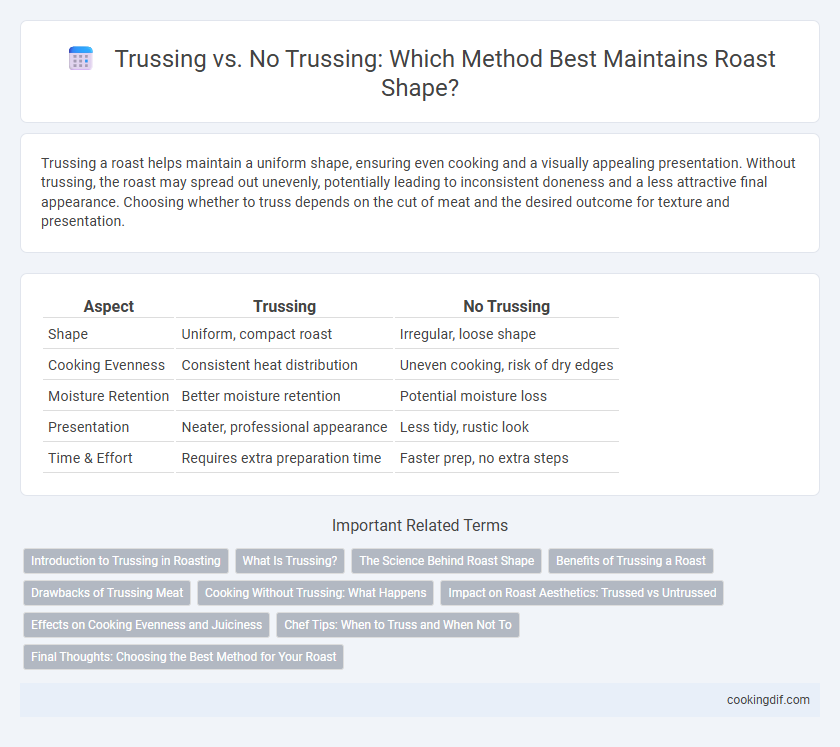Trussing a roast helps maintain a uniform shape, ensuring even cooking and a visually appealing presentation. Without trussing, the roast may spread out unevenly, potentially leading to inconsistent doneness and a less attractive final appearance. Choosing whether to truss depends on the cut of meat and the desired outcome for texture and presentation.
Table of Comparison
| Aspect | Trussing | No Trussing |
|---|---|---|
| Shape | Uniform, compact roast | Irregular, loose shape |
| Cooking Evenness | Consistent heat distribution | Uneven cooking, risk of dry edges |
| Moisture Retention | Better moisture retention | Potential moisture loss |
| Presentation | Neater, professional appearance | Less tidy, rustic look |
| Time & Effort | Requires extra preparation time | Faster prep, no extra steps |
Introduction to Trussing in Roasting
Trussing in roasting involves tying the meat with kitchen twine to maintain a compact, uniform shape, ensuring even cooking and an attractive presentation. Proper trussing helps retain juices by minimizing surface exposure, which enhances flavor and texture. Without trussing, roasts may spread unevenly, resulting in inconsistent cooking and a less visually appealing dish.
What Is Trussing?
Trussing is the culinary technique of tying a roast with kitchen twine to secure its shape during cooking, ensuring even heat distribution and consistent roasting. It helps maintain a compact form, preventing irregular bulges and allowing for uniform browning and juiciness. Without trussing, roasts may spread unevenly, leading to uneven cooking and a less visually appealing presentation.
The Science Behind Roast Shape
Trussing a roast maintains a uniform shape by evenly distributing heat, promoting consistent cooking and reducing moisture loss through minimized surface area exposure. Without trussing, the roast may expand irregularly, leading to uneven heat penetration and variable texture due to differential heat transfer rates. Scientific studies show that controlled shape enhances Maillard reaction uniformity, optimizing flavor development and juiciness.
Benefits of Trussing a Roast
Trussing a roast helps maintain its shape during cooking, ensuring even heat distribution for consistent doneness throughout the meat. It prevents the roast from spreading out or collapsing, which can lead to uneven cooking and a less attractive presentation. By securing the roast firmly, trussing allows juices to be retained more effectively, resulting in a juicier and more flavorful final dish.
Drawbacks of Trussing Meat
Trussing meat can restrict even heat circulation, leading to uneven cooking and potentially undercooked sections inside the roast. The tight binding may also cause the meat to lose its natural juices, resulting in a drier, less flavorful outcome. Additionally, trussing can mask the roast's natural shape, limiting the development of a well-browned, crispy crust.
Cooking Without Trussing: What Happens
Cooking a roast without trussing allows the meat to expand naturally, often resulting in uneven cooking and a less uniform shape. The absence of trussing can cause the roast to cook faster on thinner parts, leading to potential drying or overcooking. However, this method can create a more rustic appearance and may enhance flavor development by exposing more surface area for browning.
Impact on Roast Aesthetics: Trussed vs Untrussed
Trussing a roast ensures a uniform, compact shape that promotes even cooking and results in a polished, professional appearance. An untrussed roast often has an irregular form, causing uneven browning and a rustic, homemade look. The choice between trussing and no trussing primarily affects roast aesthetics by influencing surface texture and overall visual appeal.
Effects on Cooking Evenness and Juiciness
Trussing a roast helps maintain a uniform shape, promoting even heat distribution and consistent cooking throughout the meat. Without trussing, irregular or loose shapes can cause uneven cooking, leading to dry edges and less juicy interior sections. Properly trussed roasts retain moisture better, resulting in a juicier and more flavorful final dish.
Chef Tips: When to Truss and When Not To
Trussing a roast helps maintain a uniform shape, ensuring even cooking and an attractive presentation, especially for cuts like beef tenderloin or rolled pork loin. Avoid trussing when roasting larger cuts with a natural uniform shape, such as prime rib or a simple roast beef, to allow better heat circulation and crust development. Chef tips emphasize trussing for delicate or uneven cuts to prevent drying out while skipping it can enhance texture and browning on well-shaped roasts.
Final Thoughts: Choosing the Best Method for Your Roast
Trussing a roast ensures even cooking and a uniform shape, enhancing presentation and moisture retention. However, skipping trussing allows for a crisper, more caramelized exterior at the expense of shape consistency. Choosing between trussing and no trussing depends on whether the priority is a polished appearance or a rustic, flavorful crust.
Trussing vs No Trussing for roast shape Infographic

 cookingdif.com
cookingdif.com